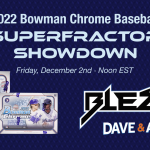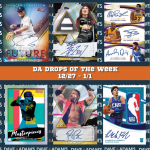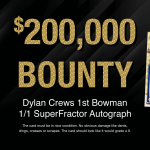Bowman Chrome buzz is still circulating the hobby two weeks after its release with some big cards still left out there to chase. I’ve seen the Ethan Salas base Superfractor with my own two eyes — but to my knowledge — the auto version has yet to be pulled. How about the Alfredo Duno auto Superfractor showing up on release day? More recently — the Brandon Mayea base Superfractor also found a home.
2023 Bowman Chrome is just another installment of one of collectors’ favorite products to prospect chase in — but did you ever wonder how it got its start? Topps Ripped piqued my interest with a series of articles detailing the beginning of Bowman Chrome and its rise.
The year is 1997 — the Bowman cards up until this point? Mostly paper — but that’s all about to change with the introduction of strictly chrome tech — giving Bowman a bit of a classier look. It was a much simpler time in the late 90s — with the debut edition of Bowman Chrome only featuring three parallels and two insert sets. Topps even shrunk the base set for collectors from regular Bowman’s 441 to a 300-card checklist made up of 100 vets and 200 rookies and prospects. Vets with a red nameplate and border — rookies and prospects with blue. It looks like the first 100 cards in the set are the league vets — and 101 and on are the prospects and rookies. It came with 24 packs per box and four cards per pack.
Something that was missing from the inaugural Bowman Chrome set was the recognizable 1st Bowman stamp that normally sits in one of the top corners of the prospect cards nowadays. However — there was a 1st Bowman stamp present on the paper Bowman set — meaning wax rippers knew it was the player’s first official baseball card — with no physical indication anywhere on the Chrome card. Funny enough — Topps ditched the designation the following year and didn’t start using the 1st Bowman logo on the Chrome set and making it a key part of the product until 2003.
The focus here is the rookies. According to my research — 1997 Bowman Chrome considers rookies the players who had 1st Bowman stamps in 1997 Bowman Baseball. It was much tougher to decipher whose cards are rookies back then — seeing as there was no RC mark on the card like there is now on just about every sports card you see. Multiple accounts consider this to be a deep rookie class — and if you’re a ’90s kid or adult who watched baseball in the early 2000s — you’ll understand why collectors of that era thought that way.
Giving Cardboard Connection a break — I decided to use another trusty source of checklist info in Trading Card Database or TCDB. rookies of the first Bowman Chrome include R.A. Dickey — Adrian Beltre — Kerry Wood — Eric Chavez — Lance Berkman — Jayson Werth – Aramis Ramirez — Miguel Tejada — and last — but certainly not least — Roy Halladay. A crop of players right there who eventually became league stars — and to reiterate — were considered to be the rookies of the set because their base Bowman cards did indeed have the indicator that it was their first card in the top left-hand corner.
Topps seems to operate 1997 Bowman Chrome like they do in 2023 — with players having no 1st Bowman stamp on their cards in Chrome because collectors could already find them in Bowman Baseball — so they have a base and refractor.
In a Ripped article — Topps also details the influence that International Signing Day had on Bowman Chrome. Topps says Bowman Chrome was a home for players who missed the Bowman cut — and a select few players held back on purpose. Here’s where the international signing period comes into play. It began on July 15 and ran through June 15 the next year — and the biggest prospects would usually sign right when the window opened and show up in Bowman the following year because July was too late to include those players in Chrome.
Scanning the checklist — some other notable names that may not have debuted or played much in the bigs in 1997 — but are still included in the blue-bordered rookie and prospect part of the set are guys like Vladimir Guerrero — Todd Helton — Scott Rolen — and Nomar Garciaparra.
But where does the value come in this set? That would be a parallel that resembles something Topps is doing in this year’s Chrome set. Did you catch the new WBC flag insert in 2023 Chrome that honors the 2023 World Baseball Classic? In the same breath — 1997 Bowman Chrome baseball featured a parallel that came one in every box. The international refractor showed the players’ birth country flag on the back and front of the card.
A quick search of the different 1997 Bowman Chrome parallels and inserts shows that the international refractors are the most valuable of the set. The top three results are Adrian Beltre — rookie international refractors. Two PSA gems and an SGC 10 with sales of four figures and the top sale being $8,500. The rookie Roy Halladay graded — and veteran Ken Griffey Jr. graded international refractors also hit the top ten sales on Card Ladder.
Most sellers look like they’re asking in the $250 to $280 range for a sealed box of 1997 Chrome — which — compared to what other late 90s boxes are going for — doesn’t seem too bad. There’s potential there to get your money back with international rookie and star refractors in a high grade — but of course — as we know — with all trading cards — that’s not always the case!
Regardless — I think it would be a fun rip to ooo and ahh over some baseball names I haven’t heard in a while and see what all the hubbub over this chromium technology and design was all about back then.
Related Posts
 1-888-440-9787
1-888-440-9787
 We Ship Internationally
We Ship Internationally
 FREE Gifts with orders $100+
FREE Gifts with orders $100+








Comments are closed.